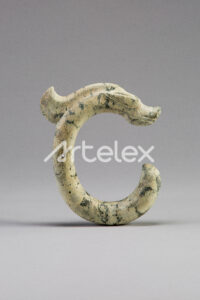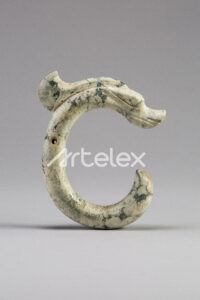C-Shaped Jade Dragon Pair: A Unique Ritual Artifact of the Hongshan Culture
This remarkable artifact is composed of two C-shaped jade dragons, designed as a matching pair. Each piece features a serpent-like body curved into a large “C” form, with detailed heads at one end. The dragons display flowing manes, a protruding snout, slit mouths, and teardrop-shaped eyes—elements that exemplify the sophisticated symbolic craftsmanship of the Hongshan culture (ca. 4500–3000 BCE).
Originally a dark moss-green, the jade has undergone whitening (baihua) over time, leaving a predominantly pale appearance. Each dragon has a small perforation slightly above the midpoint of the body, suggesting they may have been used as ritual pendants, suspended ornaments, or as part of ceremonial regalia.
A similar piece is known to exist in the Jin Dan Museum, but to date, no other known pair of C-shaped jade dragons has been identified. The presence of two symmetrical dragons reinforces themes of duality, cosmological balance, and paired spiritual forces, concepts deeply embedded in early East Asian ritual ideology.
With its unique form, rarity, and intricate detail, this C-shaped jade dragon pair is not merely an artistic artifact but a profound symbol of Hongshan culture’s worldview. It invites further exploration into ancient jade use in shamanic rites, symbolic animal representations, and the evolution of dragon iconography in East Asia.


